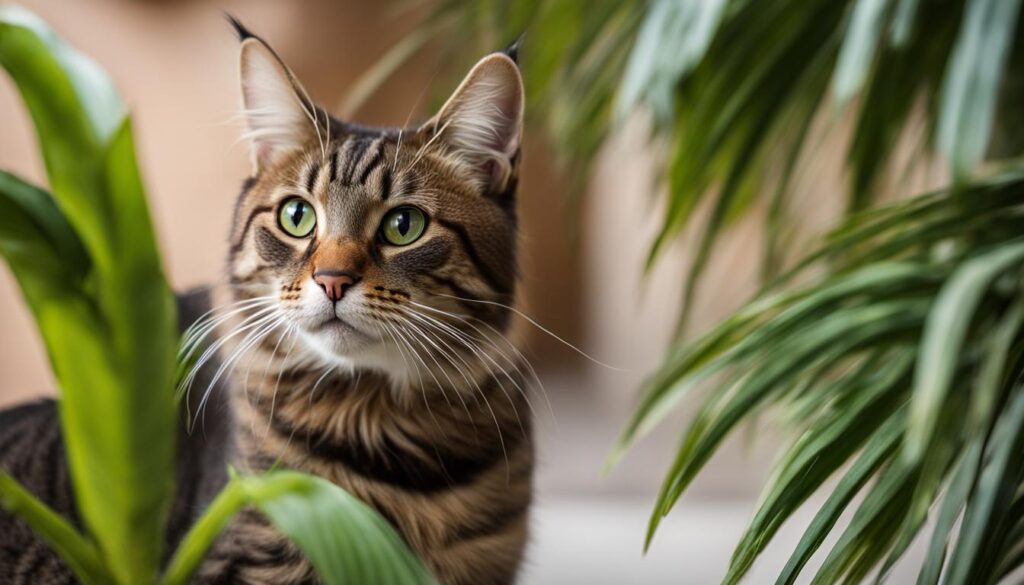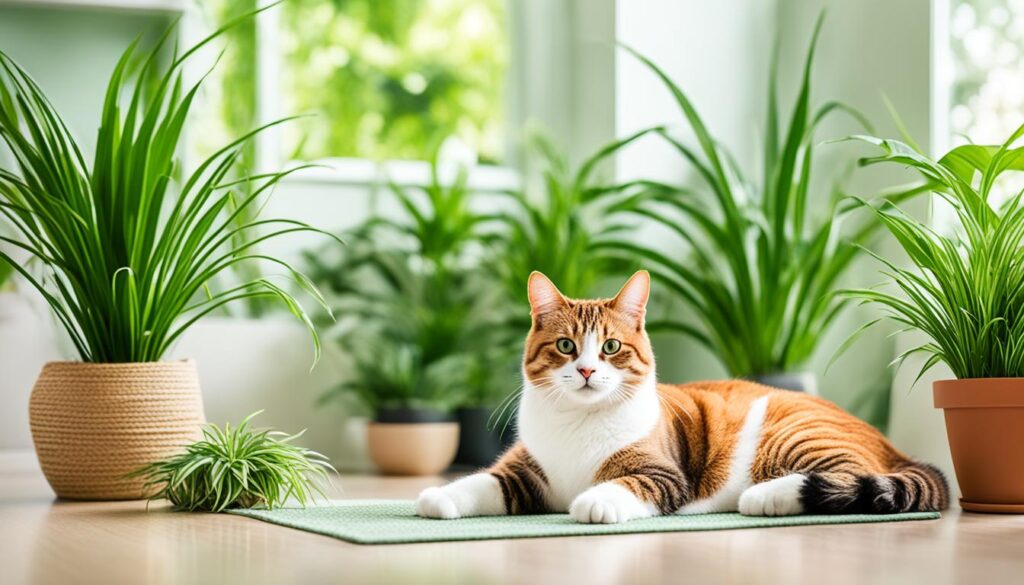Majesty Palms & Cat Safety: Toxic or Safe?
Welcome to our guide on Majesty Palms and their safety for cats. If you’re a proud cat owner and a plant enthusiast, you may have wondered about the potential risks of certain houseplants to your feline friends. In this article, we’ll explore the topic of Majesty Palms, their toxicity levels, and how to ensure a safe environment for your pets.
Many pet owners are concerned about the safety of common houseplants, especially when it comes to cats. Majesty Palms, also known as Ravenea rivularis, are prized for their lush green fronds and tropical appeal. Thankfully, these beautiful plants are non-toxic to cats, making them a safe choice for cat-friendly households.
While Majesty Palms are generally considered safe for cats, it’s important to note that consuming large quantities of the plant can cause digestive discomfort. However, the likelihood of a cat ingesting a significant amount of palm is low. Ensuring proper care and monitoring your cat’s interaction with the plant are key to maintaining a safe environment.
It’s essential to be aware of other toxic houseplants that can pose serious risks to your feline friends. Some popular plants, including peace lilies, aloe vera, jade plants, snake plants, ivy, sago palms, and pothos, should be avoided as they can lead to various health issues in cats, ranging from vomiting and diarrhea to more severe consequences.
Key Takeaways:
- Majesty Palms are non-toxic to cats and considered safe for feline friends.
- While they may cause some digestive discomfort if ingested in large quantities, they do not pose a significant risk to cats.
- Other popular houseplants, such as peace lilies, aloe vera, jade plants, snake plants, ivy, sago palms, and pothos, should be avoided as they are toxic to cats.
- To prevent cats from chewing on plants, provide alternative options such as cat grass or catnip and use deterrents like double-sided sticky tape.
- Proper placement, maintenance, and care are essential when incorporating Majesty Palms into a cat-friendly environment.
Majesty Palms and Cats: What You Need to Know
Majesty Palms are an excellent choice for households with cats, as they are non-toxic and considered safe plants. However, it is essential to be aware of a few considerations when it comes to cats and majesty palms.
The thin fibrous fronds of the palm can be challenging for a cat’s digestive system to break down if eaten in large quantities. In such cases, there is a potential for gastrointestinal upset and discomfort. However, it’s worth noting that the likelihood of a cat consuming a large quantity of palm is low. Cats are typically selective eaters and tend to nibble on plants rather than consuming them in large amounts.
Nevertheless, it is always best to monitor your cat’s interaction with plants, including majesty palms. If you notice any symptoms of distress or illness in your cat, it is advisable to consult a veterinarian for further guidance.
To summarize, while majesty palms are non-toxic to cats, it is essential to ensure that your cat doesn’t consume large quantities. By being vigilant and attentive to your cat’s behavior, you can create a safe and enjoyable environment for both your feline companion and your majesty palm.
Tips for Creating a Cat-Friendly Environment with Majesty Palms:
- Place the palm in a location that is out of your cat’s reach to prevent them from nibbling on the fronds.
- Consider using hanging plants or plant cages to keep the palm elevated and inaccessible to curious cats.
- Regularly prune any brown or yellow fronds to maintain the plant’s health and reduce temptation for cats to interact with fallen leaves.
- Choose pet-friendly repellents or deterrents to discourage cats from chewing or playing with the palm.
- Monitor your cat’s behavior around the palm plant, and if necessary, provide alternative distractions or cat-friendly plants.
- Ensure proper watering and fertilizing of the palm while avoiding the use of toxic substances that may harm your cat.
By following these tips, you can create a cat-friendly environment with majesty palms while prioritizing the safety and well-being of your furry friend.
Why Cats Chew on Houseplants and How to Prevent It
Cats are curious creatures, and their fascination with houseplants is no exception. Whether it’s a nibble here or there or a full-on chewing session, cats have various reasons for indulging in this behavior. Understanding why cats chew on houseplants can help you prevent any potential issues and create a cat-friendly environment.
One of the reasons cats chew on houseplants is out of boredom. Cats are natural hunters, and their instinct to explore and stay active can lead them to seek out new and interesting objects, including your houseplants. Additionally, some plants, such as majesty palms with their long, dangling leaves, can stimulate a cat’s hunting instincts, making them more enticing to chew on.
In other cases, cats may chew on houseplants as a way to satisfy their curiosity. They may be attracted to the texture, taste, or smell of certain plants, prompting them to indulge in a quick chew or bite.
“Cats may also chew on houseplants as a form of attention-seeking behavior,” says Dr. Sarah Thompson, a veterinarian at Pawsome Veterinary Care. “If a cat feels neglected or wants to get your attention, chewing on plants can be an effective tactic.”
To prevent cats from chewing on your houseplants, it’s important to provide alternative options that are safe and appealing to your feline friend.
Create a Cat-Friendly Garden
“One of the best ways to prevent cats from chewing on your houseplants is to create a cat-friendly garden,” advises Dr. Thompson. “This means dedicating a space in your home or yard where your cat can explore and indulge their natural instincts without harming themselves or your plants.”
You can create a cat-friendly garden by planting cat grass or catnip. These plants are safe for cats to chew on and can fulfill their desire for natural greens. Growing these plants in an accessible area will divert your cat’s attention from your houseplants.
Make Houseplants Less Appealing
There are several strategies you can employ to make your houseplants less appealing to cats:
- Place double-sided sticky tape around the base of your plants. Cats dislike the sticky texture and will be deterred from approaching and chewing on the plants.
- Surround your pots with uncomfortable objects like pinecones, rocks, or aluminum foil. The rough or crinkly textures will discourage cats from coming close.
Additionally, keeping your houseplants out of reach or in rooms that are inaccessible to your cat can help prevent chewing behavior.
Cat-Safe Plants for a Pet-Friendly Home
| Plant | Scientific Name | Toxicity to Cats |
|---|---|---|
| Spider Plant | Chlorophytum comosum | Non-toxic |
| Ponytail Palm | Beaucarnea recurvata | Non-toxic |
| Venus Flytrap | Dionaea muscipula | Non-toxic |
| Polka Dot Plant | Hypoestes phyllostachya | Non-toxic |
| Peperomia | Peperomia spp. | Non-toxic |
In addition to these strategies, it’s important to pay attention to your cat’s behavior and provide mental and physical stimulation. Engaging your cat in interactive play sessions, offering toys and scratching posts, and ensuring they have a comfortable and enriching environment can help reduce the likelihood of them seeking out houseplants for entertainment.

By understanding why cats chew on houseplants and implementing preventive measures, you can create a safer and more enjoyable environment for both your cat and your plants.
Creating a Cat-Safe Environment with Majesty Palms
When incorporating majesty palms into a cat-friendly environment, it’s essential to prioritize the safety and well-being of your furry friends. By considering placement, maintenance, and proper care, you can ensure a cat-safe environment while enjoying the beauty of these majestic plants.
Placement and Maintenance
To create a cat-safe environment with majesty palms, start by carefully selecting a suitable location for the plant. Place the palm in an area with indirect sunlight, as direct sunlight can lead to scorching of the leaves. Additionally, make sure the palm is out of your cat’s reach to prevent any unwanted interactions.
Regular maintenance is crucial in keeping your majesty palm healthy and reducing the temptation for cats to play with fallen leaves. Prune any brown or yellow fronds to maintain the plant’s appearance and prevent cats from nibbling on them. This not only helps protect your cat from potential hazards but also promotes the overall health of the plant.
Proper Watering and Fertilizing
Maintaining proper watering and fertilizing routines is essential for the health of your majesty palm and the safety of your cat. Overwatering can lead to root rot, while underwatering can cause the plant to wilt and become stressed. Ensure that the soil remains evenly moist, but not waterlogged, and avoid allowing the plant to sit in standing water.
When it comes to fertilizing, opt for pet-friendly organic fertilizers to avoid any potential harm to your cat. Follow the manufacturer’s instructions for dosage and frequency, as too much fertilizer can be detrimental to the palm and your cat’s safety.
Pet-Friendly Repellents and Plant Cages
In some cases, cats may still be tempted to nibble on or play with your majesty palm. To discourage this behavior, consider using pet-friendly repellents near the plant. These repellents emit scents that cats find unappealing, effectively keeping them away from the palm.
Another option is to use plant cages or hanging plants to physically prevent your cat from reaching the palm. This can provide an added layer of protection, ensuring both the safety of your cat and the well-being of your majesty palm.
| Creating a Cat-Safe Environment with Majesty Palms | |
|---|---|
| Placement and Maintenance | Choose a location with indirect sunlight and out of your cat’s reach. Regularly prune fronds to reduce temptation. |
| Proper Watering and Fertilizing | Maintain even moisture levels in the soil and use pet-friendly fertilizers following the manufacturer’s instructions. |
| Pet-Friendly Repellents and Plant Cages | Use pet-friendly repellents and consider using plant cages or hanging plants to keep cats away. |
By implementing these cat-friendly plant care practices and creating a safe environment, you can enjoy the beauty of majestic palms without compromising the well-being of your beloved feline companions.
Safe Alternatives to Majesty Palms for Cat-Friendly Indoor Plants
If you want to add more greenery to your home while keeping your furry friends safe, there are plenty of cat-friendly indoor plants to choose from. These non-toxic plants provide a beautiful and safe environment for both you and your cats. Here are some popular options:
- Spider Plants
- Ponytail Palms
- Venus Flytraps
- Polka Dot Plants
- Peperomias
- Boston Ferns
- Bromeliads
- Baby Tears
- Orchids
- Cat Grass
These plants not only add beauty to your home but also provide a safe alternative to majesty palms. They are non-toxic to cats, so you can have peace of mind knowing that your feline friends can safely explore and interact with these plants without any harm.
Spider Plants
Spider plants are one of the most popular cat-safe indoor plants. Their long, arching leaves and cascading tendrils make them visually appealing and irresistible to cats. They are non-toxic and can be a great addition to any cat-friendly home.
Boston Ferns
Boston ferns are known for their lush, feathery fronds and are an excellent choice for cat-friendly gardening. These ferns are non-toxic and can thrive in both high and low-light conditions, making them versatile and easy to care for.
Ponytail Palms
Ponytail palms are unique and eye-catching plants that are safe for cats. With their long, curly leaves that resemble a ponytail, these palms can add a touch of whimsy to any room while providing a safe and non-toxic environment for your feline companions.
Orchids
Orchids are elegant and beautiful flowers that can make a stunning addition to any cat-friendly space. While many orchid varieties are safe for cats, it’s important to double-check the specific type you’re considering to ensure it’s non-toxic.
Cat Grass
Cat grass is not only safe for cats to chew on but also provides numerous health benefits. It aids in digestion, provides essential nutrients, and can help prevent hairballs. Cat grass is easy to grow and maintain, making it a perfect option for both you and your cat.
When choosing cat-friendly indoor plants, make sure to research and verify the safety of any new plant before bringing it into your home. And remember, creating a cat-friendly environment is a combination of providing safe plants, monitoring your cat’s behavior, and ensuring they have alternative options for play and stimulation.
| Plant | Characteristics |
|---|---|
| Spider Plants | Long, arching leaves; safe for cats |
| Ponytail Palms | Curly leaves resembling a ponytail; non-toxic to cats |
| Venus Flytraps | Carnivorous plants; safe for cats |
| Polka Dot Plants | Colorful foliage; non-toxic to cats |
| Peperomias | Variegated leaves; safe for cats |
| Boston Ferns | Lush, feathery fronds; non-toxic to cats |
| Bromeliads | Colorful, tropical plants; safe for cats |
| Baby Tears | Dainty, cascading leaves; non-toxic to cats |
| Orchids | Elegant flowers; specific types are safe for cats |
| Cat Grass | Grass for cats to nibble on; beneficial for digestion |
When it comes to creating a cat-friendly indoor garden, these plants are safe alternatives to majesty palms. They provide a charming and pet-safe environment while adding life and freshness to your home.

Tips for Caring for Majesty Palms and Ensuring Pet Safety
In caring for a majesty palm and ensuring the safety of your pets, there are some essential tips to keep in mind. Proper care and maintenance of your majesty palm will not only promote its health but also create a pet-friendly environment in your home.
Maintain Proper Watering, Pruning, and Fertilizer Application
Majesty palms thrive in moist soil, so it’s important to water them regularly. Make sure the soil is consistently damp but not waterlogged. Overwatering can lead to root rot and other health issues for the palm. On the other hand, underwatering can cause the fronds to turn brown and dry out.
Pruning your majesty palm is also crucial for both its appearance and your pet’s safety. Remove any brown or yellow fronds to maintain the plant’s health and aesthetics. Fallen fronds can be tempting for cats to play with, so keeping them trimmed reduces the risk of accidental ingestion.
When it comes to fertilizer application, choose pet-friendly and non-toxic options. Avoid using fertilizers that contain chemicals harmful to pets. Consult your local garden center or a professional landscaper for safe fertilizer recommendations.
Monitor Your Pet’s Interaction and Provide Distractions
Regularly monitor your pet’s interaction with the majesty palm. While the palm is non-toxic, excessive chewing or ingestion of leaves can cause gastrointestinal upset. If you notice your pet showing a keen interest in the palm, redirect them to alternative distractions, such as cat grass or catnip. Providing these alternatives can help satisfy your pet’s natural instinct to chew and play, reducing the likelihood of them focusing on the palm.
Wipe Down Leaves and Avoid Toxic Substances
To keep your majesty palm clean and dust-free, wipe down the leaves regularly. This will not only improve its aesthetic appeal but also prevent the accumulation of dust and potential allergens. Additionally, avoid using toxic substances, such as harsh chemicals or pesticides, on or near the palm. These substances can be harmful to both your pet and the plant.
By following these care tips, you can ensure the well-being of your majesty palm and create a pet-friendly environment in your home. Remember, a healthy and happy majesty palm can coexist harmoniously with your furry friends.
Conclusion
In conclusion, majesty palms are a feline-friendly choice for indoor plants, as they are non-toxic and pose minimal risk to the health of your cats. However, it’s important to be aware of other houseplants that may be toxic to cats and take necessary precautions to create a safe environment for your furry friends.
By understanding cat behavior and providing alternative options such as cat grass or catnip, you can help redirect their chewing instincts away from potentially harmful plants. Additionally, maintaining proper plant care and placing palms out of your cat’s reach can further ensure their safety.
While majesty palms are a safe choice, it’s always a good idea to research the safety of any new plants and consult with a veterinarian if you have any concerns. With the right knowledge and precautions, you can enjoy the beauty of indoor plants while keeping your cats happy and safe.
FAQ
Are majesty palms toxic to cats?
Majesty palms are non-toxic to cats and considered safe for feline friends.
What should I do if my cat ingests a large quantity of majesty palm?
While majesty palms are non-toxic, eating a large quantity may cause gastrointestinal upset. Monitor your cat’s symptoms and consult a veterinarian if needed.
Why do cats chew on houseplants?
Cats may chew on houseplants out of boredom, curiosity, or a desire for attention.
How can I prevent my cat from chewing on plants?
Provide alternative options like cat grass or catnip, use deterrents like double-sided sticky tape, or keep plants out of reach.
What precautions should I take when incorporating majesty palms into a cat-friendly environment?
Keep the palm in a spot with indirect sunlight and out of your cat’s reach. Prune any fallen leaves and use pet-friendly repellents if needed.
What are some safe alternatives to majesty palms for cat-friendly indoor plants?
Consider spider plants, ponytail palms, Venus flytraps, polka dot plants, peperomias, Boston ferns, bromeliads, baby tears, orchids, or cat grass.
How do I care for majesty palms and ensure pet safety?
Maintain proper watering, pruning, and fertilizer application. Monitor your pet’s interaction and wipe down leaves regularly.
Are majesty palms a safe choice for households with cats?
Yes, majesty palms are considered safe as they are non-toxic and pose minimal risk to feline health.


